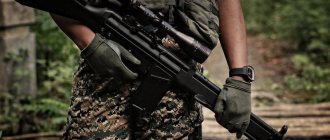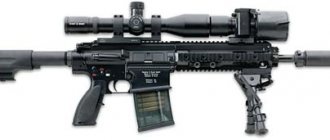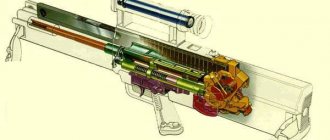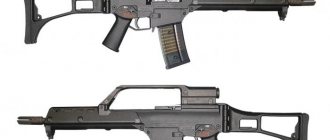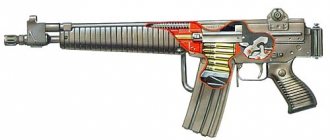The German hk g36 rifle is one of the best assault rifles in the world and is a favorite of special forces and mercenaries. Perhaps the Heckler-Koch G36 is a rather unusual weapon. It makes an ambiguous impression: it looks light and fragile, and it is clear that most of the elements are made of plastic. At the same time, the rifle has an interesting design and clear edges, the polymer stock and box are pleasant and soft to the touch, everything looks a little futuristic and very harmonious.
But if you take the rifle in your hands, you immediately feel the heaviness (without ammunition it weighs 3.6 kg), which is a lot for a plastic rifle. But it all lies in the stiffening ribs located along the entire length of the butt and receiver. Thanks to this, the rifle is resistant to deformation and damage. The gaps are minimal, there is no movement of the fore-end and butt - the rifle is made at a high level.
History of the creation of the HK G36
The assault rifle was created by the German company Heckler&Koch in the early 1990s. The designers were given the task of replacing the HK G3, an automatic rifle of 7.62 caliber, in the troops. The decision was made back in 1970. The development of the new rifle was entrusted to Heckler&Koch, which created the HK G11 rifle. However, it was not adopted.
In 1992, the question of replacing the G3 arose again, due to several reasons:
- Development of the service life of the small arms used (including G3 and MG3).
- Adjustment to the NATO standardization program, which recommended the 7.62x51 cartridge only for single machine guns, as well as sniper rifles.
- Higher practical efficiency of using low-pulse cartridges.
- The main tasks of the Bundeswehr also changed, including: peacekeeping and counter-terrorism operations, the fight against drug trafficking, piracy and smuggling, for which the heavy and bulky HK G3 rifle was poorly suited.
In 1993, the company developed new tactical and technical requirements for a light machine gun and rifle, and instead of financing the development, it was decided to conduct a competitive selection of samples. During military trials and comparative tests, the choice was made in favor of the HK G36 rifle, as well as the HK MG36 light machine gun. By September 1996, the rifle began to be supplied to infantry troops participating in crisis regions, and then other units of the Bundeswehr were also equipped with it.
Notes
- ↑ 12
G-36 assault rifle misses target | InoSMI - Everything that is worthy of translation Archived on October 21, 2016. - ↑ 123456789101112
G36 | Technical Data (inaccessible link). heckler-koch.com. Access date: July 25, 2015. Archived June 23, 2014. - ↑ 1234567891011
G36K | Technical Data (inaccessible link). heckler-koch.com. Access date: July 25, 2015. Archived October 8, 2014. - ↑ 1234567891011
G36C | Technical Data (inaccessible link). heckler-koch.com. Access date: July 25, 2015. Archived November 9, 2014. - ↑ 123
Assault Rifles (English) (unavailable link). heckler-koch.de. Access date: September 11, 2010. Archived March 14, 2011. - HK G36 | History Wars Weapons Archived February 1, 2014.
- G36 | Accessories (English). heckler-koch.com. Access date: July 25, 2015.
- ↑ 12
The most modern weapons and military equipment, 2022, p. 52-53. - I.K.
Cassanelli. Modern firearms. - “Family Leisure Club”, 2013. - P. 131. - 301 p. — ISBN 978-996-14-7261-6. - ↑ 12
Bundeswehr: G36-Sturmgewehr ist nicht treffsicher | ZEIT ONLINE - Sturmgewehr G36 hat in der Bundeswehr keine Zukunft (undefined)
. faz.net (April 22, 2015). Access date: April 23, 2015. - G36 | Unrestricted speed and mobility (inaccessible link). heckler-koch.com. Access date: July 25, 2015. Archived March 30, 2015.
- machine/assault rifle G36A1 / [email protected] (unspecified)
(inaccessible link). armsatwars.info. Retrieved April 9, 2018. Archived April 9, 2022. - Heckler & Koch G36 – Internet Movie Firearms Database – Guns in Movies, TV and Video Games
- ↑ 12
Description of HK SL9SD on the HKPRO website - HK243 SAR | Semi Automatic Rifle - Sporter Basic Variant (English) (unavailable link). heckler-koch.com. Access date: July 25, 2015. Archived November 2, 2014.
- HK243 S TAR | Tactical Automatic Rifle - Sporter Professional (English) (unavailable link). heckler-koch.com. Access date: July 25, 2015. Archived October 29, 2014.
- HK243 SAR | Technical Data (English). heckler-koch.com. Access date: July 25, 2015.
- HK243 S TAR | Technical Data (English). heckler-koch.com. Access date: July 25, 2015.
- Riller's guns and stuff bloggothingy: G36s, and how they're melty pieces of shit not fit for a solider Archived May 12, 2014.
- Lenta.ru: Science and technology: The Germans encountered overheating of G36 assault rifles
- The Germans encountered overheating of the G36 assault rifles: Science and technology: Lenta.ru
- Magazine "Kalashnikov" No. 5/2015. Weapon panorama page 7
- AusTender: Contract Notice View - CN53453
- AFP buys new weapon for International Deployment - G36C // “Response Australia” issue 8, 2011
- N. Krasin. On the supply of German small arms to Georgia // “Foreign Military Review”, No. 10 (739), 2008. p. 80
- Latvia switches to German rifles // LENTA.RU dated November 1, 2006
- The Latvian army will receive new weapons // DELFI.LV from October 30, 2006
- DOCUMENTAR MEDIANTE FECHAS, EL INICIO DEL PROYECTO DE LA SEDENA PARA FABRICAR EN MÉXICO EL FUSIL HK G-36V, LOS RAZONAMIENTOS Y JUSTIFICACIONES TÉCNICAS Y MILITARES PARA LLEVAR A CABO DICHO PROYECTO (Spanish) (December 15, 2006). Access date: May 23, 2009.
- Z czego strzela Policja? Archived copy from October 22, 2012 on the Wayback Machine // “Policja 997”, Nr 51, June 2009
- Deutsche G36-Sturmgewehre werden ab 2012 auch direkt in Saudi-Arabien hergestellt (German) (13 August 2012).
- Vladimir Krashevsky. Professionals: sixth team Archived copy dated May 27, 2014 on the Wayback Machine // “Brother” magazine, January 2011
Performance characteristics
- Caliber – 5.56×45 mm.
- Locking - turning the shutter.
- The operating principle of the automation is based on the removal of powder gases.
- Length (stock folded) – 999 (758) mm.
- Height without magazine – 263 mm.
- Height with magazine – 320 mm.
- Width (stock folded) – 64 (98) mm.
- Barrel length – 488 mm.
- Rifling – 6 right-hand rifling.
- The rifling pitch is 178 mm.
- The bore is chrome plated.
- The initial bullet speed is approximately 920 m/s.
- The muzzle energy of the bullet is 1725 J.
- Target firing range – 800 m.
- Effective firing range – 500 m.
- Maximum firing range – 2860 m.
- Bipod weight – 0.21 kg.
- Empty magazine weight: 0.127 kg.
- Weight without bipod and magazine – 3.63 kg.
- The weight of a magazine with 30 rounds is 0.483 kg.
- Type of fire - single or automatic.
- The rate of fire is 750 rounds/min.
- Magazine capacity – 30 rounds.
- The trigger force is 30...55 N.
- Bullet weight – 4 grams.
- Sights: 3x optical sight ZF 3×40, collimator sight.
Heckler-Koch G36 design
The G36, unlike earlier developments, has automation similar to the American AR-18 weapon. It is built on the basis of a gas engine with a short stroke of the gas piston. The barrel is locked by turning the bolt to all 7 lugs.
On the top of the box there is a cocking handle that can bend 90 degrees in both directions, providing ease of use for both left- and right-handed people. In the stowed position, the rifle is placed parallel to the axis of the weapon.
The trigger, which is attached to the box with transverse pins, is made in the form of a block with a trigger guard, as well as a pistol grip. The trigger mechanism can have several options; they differ in the possibility of firing a burst with a cut-off of 3 rounds. A flag-type fuse-translator is used.
Plastic is widely used in the design of the machine gun, for example, in the folding stock, forend and receiver. To partially disassemble the rifle, simply press on the pins with your fingers to push them out. The magazines for monitoring consumption are made of transparent plastic. They also have special mounts that make it possible to combine magazines in pairs to speed up reloading.
Machine guns and assault rifles
HK G 36 1
The G36 assault rifle has been developed by the German company Heckler Und Koch since the early 1990s under the in-house designation HK50. In 1995, the G36 was adopted by the Bundeswehr (German Army), and in 1999 by the Spanish Armed Forces. In addition, the G36 is used by the UK police (mainly in the G36SL self-loading version) and is exported to the USA for sale to law enforcement agencies there. Especially for the civilian market, based on the G36 automatic rifle, Heckler Und Koch released the SL-8 self-loading rifle in .223 Remington caliber.
The somewhat modernized G36K rifle with a shortened barrel also served as the basis for the creation of the “kinetic” component of the promising American OICW XM-29 SABR system, developed jointly by the American company ATK and Heckler-Koch. Moreover, according to the most recent data, a version of the G36 rifle, created for the OICW system, can be adopted by the US Army as a separate model under the designation “XM-8 light assault rifle” (XM-8 light assault rifle), to replace the failed hope for Colt M4 carbines.
The G36 rifle is significantly different from previous HK developments, built on the basis of automatics with a semi-free jam (G3, NK33 and others), and in its design is more reminiscent of the development of the American Armalite AR-18 rifle than the previous proprietary systems of Heckler Und Koch. At the same time, this rifle uses a number of solutions developed on the experimental Heckler Und Koch HK36 rifle, developed in the first half of the 1970s. These solutions include a removable handle with integrated optical sights, as well as a folding cocking handle that allows you to cock the weapon with either hand.
Overall, the G36 is a first-class example: a light, comfortable and reliable weapon, although, like any other, it is not without some shortcomings. From personal correspondence, the author knows the following problems discovered during the operation of the G36 rifles: police officers in one of the US states were faced with the fact that the sights on the shortened G36KE rifles lose sight over time. Additionally, during testing in Norway, Norwegian Navy sailors found the G36's charging handle to be very uncomfortable to use while wearing thick gloves or winter mittens, which are absolutely necessary in Norway's harsh northern climate. Early examples of the G36 also suffered from overheating of the forend during intense shooting, but currently production G36 rifles are equipped with a forend with improved thermal protection. However, it must be borne in mind that these problems, as far as I know, were not officially covered, and the author became aware of them from private sources.
The G36 rifle is built on an automatic basis with a gas engine with a short stroke of the gas piston. The gas outlet unit is designed in such a way that waste and excess powder gases are removed from the unit forward, towards the muzzle, reducing gas pollution in front of the shooter's face. In addition, the gas outlet unit is designed taking into account self-regulation - it uses just enough powder gases to provide the necessary impulse to the moving parts of the automation, and excess gases are discharged into the atmosphere. Thus, it was possible to achieve smooth operation of the automation without the use of manual gas regulators.
The rifle's bolt is rotatable, has 7 lugs, and is located in the bolt frame, which moves along one guide rod, which also has a return spring. On the upper surface of the bolt frame there is a cocking handle protruding above the upper surface of the receiver. In the stowed position, the cocking handle is located along the axis of the weapon and is held in this position by a spring, and for cocking it can be bent in any direction by about 90 degrees. When firing, the handle moves along with the bolt frame. If necessary, the cocking handle can be locked in the open (unfolded) position by sliding it towards the axis of the weapon, after which the handle can be used to close the bolt manually. In order for the bolt handle to fold, you need to slightly pull it outward and then release it. The mechanism of the G36 rifle includes a bolt stop that intercepts the bolt group in the open (rear) position when all the cartridges in the magazine are used up. To remove the bolt from the slide stop, you need to slightly pull it back by the charging handle and then release it. The ejection of spent cartridges is carried out on the right side of the weapon, and behind the ejection window of the receiver there is a protrusion-reflector that directs the ejected cartridges forward, away from the shooter’s face (when firing from the left shoulder).
The receiver of the rifle is made of plastic with steel inserts. The body of the trigger mechanism is made in the form of a separate single block along with the pistol grip and trigger guard, and is attached to the receiver using transverse pins. The trigger mechanism can be supplied in several versions - with or without an additional firing mode with a cut-off of 2 or 3 rounds. The plastic handguard is also pinned to the receiver, so that partial disassembly requires only a cartridge or other object suitable for pushing the pins out of the holes. In addition, the plastic fore-end does not touch the barrel, and the bipod, if necessary, is attached to the fore-end, which increases the accuracy of single shots, especially at long distances.
The buttstock of the G36 is framed, folds sideways, and is made of plastic. Shortened G36C assault rifles have butts of slightly shorter length, identical in design to the G36 and G36K butts. On the upper surface of the receiver there is a large carrying handle, in the rear of which there are sighting devices. The standard G36 has two sights - an optical magnification of 3.5X, and a red dot sight located above it, intended for use at close ranges. Both sights are manufactured by the German company Hensoldt AG. The export version of the G36E rifle (used in the Spanish armed forces) and the shortened G36K “carbine” have only one 1.5X optical sight, as well as backup open sights (fixed rear sight and front sight), made on the upper surface of the carrying handle. An even shorter version of the G36C (C stands for Compact or Commando) instead of a carrying handle, has universal Picatinny-type rails for attaching sights of any type. The collimator sight is designed for shooting at ranges of up to 200 meters; external natural light is used to illuminate the aiming mark - a special light guide is built into the sight. The brightness of the aiming mark is adjusted automatically. The optical sight also zeros in at a range of 200 meters, and has additional marks for shooting at ranges of 400, 600 and 800 meters, as well as an additional rangefinder reticle for determining the distance to a target height of 1.75 meters (standing person) in the range from 200 to 800 meters.
The G36 is fed from transparent plastic magazines with 30 rounds of ammunition, which have special fastenings on the side walls for combining the magazines into “packages” to speed up reloading. Magazines for the G36, due to the design of the mounting in the weapon, are incompatible with the NATO standard (magazines from the American M16 rifle), however, thanks to the modular design, the standard G36 magazine receiver with a latch behind the receiver window (like a Kalashnikov assault rifle) can, if necessary, be easily replaced in the field with a receiver NATO standard magazines with side latch.
The G36 can be equipped with a bayonet (bayonets from AKM assault rifles from the reserves of the former People's Army of the GDR are used) or a 40 mm under-barrel grenade launcher AG36 manufactured by Heckler Und Koch, in addition, the G36 flash suppressor has a standard diameter and can be used for throwing rifle grenades (though , the automatic rifle does not provide a gas valve for cutting off powder gases, and therefore such a practice is hardly recommended unless absolutely necessary).
Options: Basic:
- G36 - basic version, automatic rifle.
- G36K (Kurz) - a shortened version, an assault rifle with a barrel length of 318 mm.
HK G 36K 1
- G36C (Compact) is an assault rifle with a 228 mm barrel and a Picatinny rail for mounting various sights instead of a carrying handle.
HK G 36C 1
Upgraded:
- G36A1 – modernized version. Supplied to troops since 2002.
- G36A2 - the second modernization of the rifle (2004). It has a new collimator sight and a modified handguard with a rail for mounting tactical accessories (usually an LLM-01 laser laser).
- G36KA1 and G36KA2 are modernized shortened versions. Picatinny rail, accessory rail under the forend, a muffler can be installed. Unlike the KA2, the KA1 variant does not have a built-in optical sight.
Export:
- G36V and G36KV (previously designated as G36E and G36KE) are export versions, distinguished by the presence of only a 1.5X optical sight.
- The G36KV2 is an export version of the G36K, featuring the installation of a “high” picatinny rail instead of a carrying handle on top of the receiver. The guide is not equipped with any sighting devices, but instead a thin longitudinal groove is used. In addition, on the KV2 modification, a “cheek rest” is installed on the standard frame stock.
- G36KV3 - the most non-standard export version of the G36, featuring a 16-inch barrel (407 mm, for the regular G36 - 480, and for the G36K - 318) with a standard slotted flash hider and bayonet mount; modified gas outlet unit; “low” picatinny rail made of aluminum with folding non-removable sights, including a front sight and a diopter; as well as a telescopic folding stock.
- G36KA4 - an export version in service with the Lithuanian army, differs from the standard G36 by the installation of an aluminum forend and an aluminum picatinny rail with integrated sights, manufactured by Brugger & Thomet.
Characteristics:
- Weight, kg: 3.63/3.77 (G36), 3.33/3.47 (G36V), 3.3/3.44 (G36K), 3/3.14 (G36KV), 2.82/ 2.96 (G36C), 3.83 (MG36), 3.5 (MG36E) without magazine/with empty magazine for 30 rounds;
- Length, mm: 999/758 (G36 G36V MG36 MG36E), 860/615 (G36K G36KV), 720/500 (G36C) with stock extended/folded;
- Barrel length, mm: 480 (G36 G36V MG36 MG36E), 318 (G36K G36KV), 228 (G36C);
- Width, mm: 64;
- Height, mm: 320 (G36 G36K MG36), 285 (G36V G36KV MG36E), 278 (G36C);
- Cartridge: 5.56x45 mm NATO;
- Caliber, mm: 5.56;
- Operating principles: removal of powder gases, rotary bolt;
- Rate of fire, rounds/min: 750;
- Initial bullet speed, m/s: 920 (G36, G36V, MG36, MG36E), 850 (G36K, G36KV);
- Maximum effective range, m: 800 (G36), 500 (G36K), 300 (G36C);
- Type of ammunition: box magazine for 30 rounds, drum magazine for 100 rounds;
- Sight: optical 3.5X and collimator (for the export version - only optical 1.5X).
Sights
Sight attachments include red dot sights and optical sights. The Hensoldt HKV sight with a conventional optical system has a magnification of 3.5 times. The rangefinder reticle and correction scale are marked only up to 800 m.
The Zeiss "red dot" red dot sight is equipped with a light-accumulating system that allows operation in daylight without the use of power sources.
The collimator sight is mounted on the top of the optics and is used for shooting at a distance of up to approximately 200 meters.
Countries that have adopted the G36 rifle for service
The assault rifle as a whole turned out to be a modern weapon, excellent, reliable, accurate and convenient. In addition to Germany itself, the rifle was adopted as the main infantry weapon by the armies of Malaysia, Indonesia, Latvia, Lithuania and Spain.
The G36 rifle, as well as its modifications in general, entered service with police and army units in over 40 countries, including the UK, USA, Poland, Brazil, Thailand, Norway, Australia and so on.
The G36 has also become widespread in popular culture (computer games, cinema), including thanks to its somewhat futuristic and original design, which made it possible for it to become one of the most recognizable rifles in the world.
Operating countries
- Albania: Army Special Forces (HK G36C).
- Australia: since 2007, a batch of G-36C[24] has been in service with the capital's Specialist Response Group special forces of the federal police; in 2008, another batch of G-36Cs was purchased for the special forces of the Australian Federal Police International Deployment Group, which provide security for embassies abroad[25]
- Brazil: Anti-Terrorist Unit, BOPE, GPI.
- UK: English police: London, Brighton; Prime Minister's Personal Guard (PMC).
- East Timor: Security Guard Of President, Police GNR (HK G36C).
- Germany: used by the Bundeswehr, KSK, combat swimmers and military police, GSG 9, SEK and Australian CPP fighters guarding employees of the Australian and German embassy in Baghdad, BKA (VIP security in Iraq).
- Guyana: Police: Security of the stadium where the President of Guyana is speaking.
- Georgia: in the period before the start of hostilities in South Ossetia, about 200 pieces were received from Germany. G36С assault rifles, which entered service with the presidential guard and special forces[26].
- Indonesia
- Jordan: Royal Special Force (RSF), Police: Anti-terror.
- Iraq: VIP protection.
- Ireland
- Spain: army special forces (including the Spanish Legion), air force, police special forces (BBT, CNP), police special forces "Ertzaintza" (HK G36C).
- Italy: Col Moschin.
- Canada: Kingston Police Emergency Response Unit.
- Cyprus
- Latvia: from November 1, 2006[27] enters the armed forces[28] and police special forces (G36KV3).
- Lebanon: special forces.
- Lithuania: armed forces (G36KA4).
- Malaysia
- Mexico: Mexican Federal Police[29]
- Netherlands
- Norway: Coastal Jaeger Unit KJK and Motorized Rifle Battalion Telemark used G36KV2 from 2001 to 2007, replaced by HK416.
- Poland: special police forces[30], border guards, special unit Formoza.
- Portugal: Air Force Commandos, TACP: Air Controllers.
- Saudi Arabia: Saudi Arabian Armed Forces (G36C)[31]
- Romania
- Singapore
- Slovakia
- Slovenia
- USA: Police: US Capitol Police, MD Baltimore City SWAT, CA North Country Orange SWAT, Iowa Cedar Rapid Special Response Team, Santa Monica, private security agencies.
- Thailand: Rangers, Navy Special Forces, Military Police, Navy SF.
- Trinidad and Tobago: special forces
- Uruguay: Army Special Forces.
- Philippines
- Finland
- France: police: GIPN, RAID, GSPR, embassy security in Kabul, EPIGN: VIP security.
- Croatia: Armed Forces, Army (SOBn) and Police Special Forces, OMLT, Police (ATVP), Anti-Terror (Specijalna Policija), Police, SPNVP SF: Military Police, BSD, Military Engineers, MP, ATJ LUCKO, MP: Exercise Jackal -9.
- Chile
- Sweden: Police (AT, NI).
- Ecuador: special forces (at the 2010 Fuerzas Comando exercise).
- Estonia
- UN: several HK G36 KE assault rifles were handed over to the UN SPECIAL TEAM SIX police group (25 people) as part of the UN mission in Kosovo (UNMIK)[32].
Benefits of G36
- G36 is characterized by high operational reliability and robust design.
- The rifle demonstrates good accuracy and shooting accuracy at a distance of up to 450 meters, and a slight toss and recoil of the barrel significantly increases the effectiveness of automatic fire.
- Significant advantages were also the low weight and ergonomics of the weapon.
- All main controls are duplicated on each side of the rifle.
- All parts of the G36 are connected using pins, which provides a modular design and also simplifies cleaning and maintenance (disassembly is carried out without special tools).
- The design of the magazines makes it possible to effectively control the consumption of cartridges, including quickly and easily combining them with each other.
- The G36 can be equipped with an AG36 grenade launcher or a bayonet.
Overheating
In April 2012, reviews appeared from the German military that the G36 rifles used in Afghanistan overheated in the fore-end area during prolonged firefights, with continuous shooting of 150 rounds. Overheating affects the G36's accuracy, making it difficult to hit targets beyond 100 meters, rendering the rifle ineffective beyond 200 meters and unable to fire effectively beyond 300 meters. In addition, the risk of misalignment and jamming of small arms, as well as the likelihood of severe burns, increases significantly.
The G36 series rifles were described as not being able to withstand prolonged firefights. HK representatives stated that the rifle was not designed for continuous, sustained fire.
The German military operations command in Afghanistan has issued an instruction to military personnel requiring mandatory cooling of the Heckler & Koch G36. According to the new instructions, after a long period of shooting, a soldier must allow the barrel of the weapon to cool enough to touch it without getting burned. By complying with this requirement, possible injury can be avoided, as well as a reduction in the effectiveness of the G36 fire[20][21]. Accuracy at a range of 300 meters dropped by 30% (2012)[22].
In December 2013, Metallwerk Elisenhütte, which for a long time supplied ammunition to the German army and police, took the blame for the reasons for the rapid overheating of the HK G36 barrels. [ source not specified 2267 days
] After lengthy investigations by independent experts, Ernst-Mach-Institut and Fraunhofer-Gesellschaft concluded that uniform supplies of cartridges to German troops in Afghanistan from different manufacturers (including defective and low-quality ones) are the cause of overheating of rifles (when firing low-quality cartridges, an increased temperature is created in barrel). [
source not specified 2267 days
] And since the barrel bore is chrome-plated, such rapid overheating due to the barrel itself is unlikely.
In June 2014, purchases of new batches of rifles were suspended. In 2015, after months of investigation, the federal government officially acknowledged accuracy problems with the G36 rifle regardless of the quality of ammunition used.[10] It turned out that during intense shooting in hot climatic conditions, critical deformation of the plastic body of the weapon can occur[23].
Disadvantages of G36
- The transparent plastic of the magazines is quite fragile (especially at low temperatures); it often breaks and cracks upon impact. But you can also use opaque aluminum magazines.
- Due to the tight fit of the piston to the walls of the gas chamber, as well as the lack of a gas regulator, the rifle begins to jam after 3-4 thousand shots without cleaning.
- Cleaning the weapon is difficult due to the inconvenient location of the barrel and gas chamber, which is aggravated by the absence of a cleaning rod in the design.
- The standard flame arrester is not very effective.
- At a distance of over 450 meters, the accuracy of fire is significantly reduced.
- During intense shooting, the handguard becomes noticeably hot.
- The G36 is one of the most expensive assault rifles.
Rifle modifications
- G36K is a shortened version of the weapon with a 318 mm barrel.
- G36C is an assault rifle with a Picatinny rail and a 228 mm barrel.
- G36A1 - modernized version of 2002.
- G36A2 - modernized version of 2004. A new collimator sight has appeared, as well as a handguard with a tire.
- G36KA1 and G36KA2 – shortened versions of G36A2 and G36A1 with the possibility of installing a muffler.
- G36V and G36KV are export rifles that differ only in the presence of an optical sight.
- HK MG36 is a special light machine gun based on the G36. Has a weighted barrel.
- SL-8 is a civilian self-loading rifle.
- HK SL9 is a sniper rifle chambered for 7.62×37. It is possible to install a muffler.
- The XM8 and HK416 are assault rifles based on the G36.
